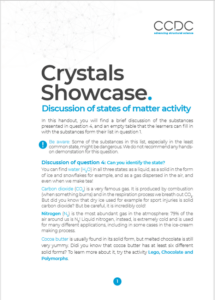Crystals Showcase
Before starting this activity, look around you: even though they are too small to see, everything is made of molecules…except elements!
Water molecules (H2O) are in your drink, the bottle holding your drink might be made of plastic, and plastic is composed of long chains of molecules, called polymers. Carbon atoms are in your pencil in the form of graphite, which you probably use to write on cellulose molecules – we mean, paper. And, if you take a deep breath, oxygen (O2) and nitrogen (N2) will enter your body and you will release carbon dioxide (CO2). The list goes on and on! For some of the molecules you see around you they form crystals, for example salt or sugar. When water freezes (going from a liquid to a solid) it forms water crystals, known as ice. In this activity we want to guide you in the exploration of the amazing world of crystals, showcased in all their beauty.
At the end of this activity, don’t forget to collect your reward! Please, ask an adult to download the collectable virtual badge.
What You Will Need:
This activity can be carried out online on a computer or you can download and print the activity worksheet.
If printing is not possible, do not worry! The activities can be done in the form of a discussion.
You will need internet access to watch the crystals showcase at the end of the activity and to visualise 3D structures.
Learning Outcomes:
In this activity you will:
- Review what a gas, liquid and solid is.
- Learn what a crystal is.
- Learn keywords related to crystals.
Recommended Age:
This activity is suitable for ages 8+ years with adult supervision and guidance.
Health & Safety:
These activities are carried out at your own risk.
Please read these health and safety guidelines to reduce risks.
- Any access to the internet for minors should be done under adult supervision.
- If you print and cut out the handouts and reward badge, please be aware of potential cuts from scissors or papers, and irritation from contact of glue with eyes, skin, hair or ingestion.
- Some of the substances mentioned in the handout, especially in the least common state, might be dangerous. We are not recommending any hands-on activity for any of these substances.
Our Downloadable Educational Resources
In this section you can find the handouts to carry on the activity.
- The first handout, “Activity”, provides a step-by-step guide to the activity.
- The handout “Discussion” is a support for the activity leaders leading discussion and reflection on the activity.
- The handout “Solutions” contains the solutions of the crosswords and words search games.
Crystals Gallery
Crystals Pictures

How beautiful are crystals? These images wow us every time!
View a slideshow of some of the crystals we bring with us at science festivals.
Do you want to see what happens when a materials scientist is also a photography lover?
Then, follow the link to admire Alex Moldovan’s “World of Crystals” gallery.
Videos of Crystallisation

Crystals forming and growing can be quite hypnotic!
Watch the video of Scratched Crystal Growth here (Vimeo).
Watch the video of Paracetamol Crystallisation here (YouTube).
Author of both videos: Alex Moldovan
Discover 3D Structures
In this (optional) part of the activity, you can look at the 3D structure of crystals from the CSD (Cambridge Structural Database). Click on a link to access the page of the chosen structure. In the page “Tips to use the 3D visualizer on structures’ webpages” you can find some tricks to play around with the 3D visualization window.
A Star of David catenane. DONCUG (doi: 10.5517/cc129n45) – view here
A molecule derived from garlic. ONILAA (doi: 10.5517/ccdc.csd.cc1kbhx9) – view here
A molecule found in coffee. KUSQIZ (doi: 10.5517/cctzmv7) – view here
Caffeine, a molecule found in coffee. CAFINE – view here
Theobromine, a molecule found in chocolate. SEDNAQ (doi: 10.5517/cc4d14p) – view here
A molecule found in a 3-year-old wine bottle. ZZZRZW04 (doi: 10.5517/cc3j72x) – view here
Paracetamol. HXACAN11 (doi: 10.5517/cc4v79h) – view here
Urea. UREAXX – view here
Alloxan. ALOXAN – view here
Note that some of these structures have multiple entries in the database. You can click on the various structures to view them.
Further Learning and Useful Links
Classroom Teaching Modules: Crystallisation
This module was developed for use in the classroom based on hands-on exercises used at the Cambridge Science Festival. Thanks to Dr Louise Dawe (Wilfrid Laurier University) for assistance with curriculum benchmarking and Prof. Robert Pike at The College of William and Mary for providing additional resources.
You can explore more structures from the CSD from Teaching subsets.
To investigate common substances, such as chocolate, lemon, and sugar, using the CSD, you can become a CSD Detective with the activity Identikit of Common Substances.



